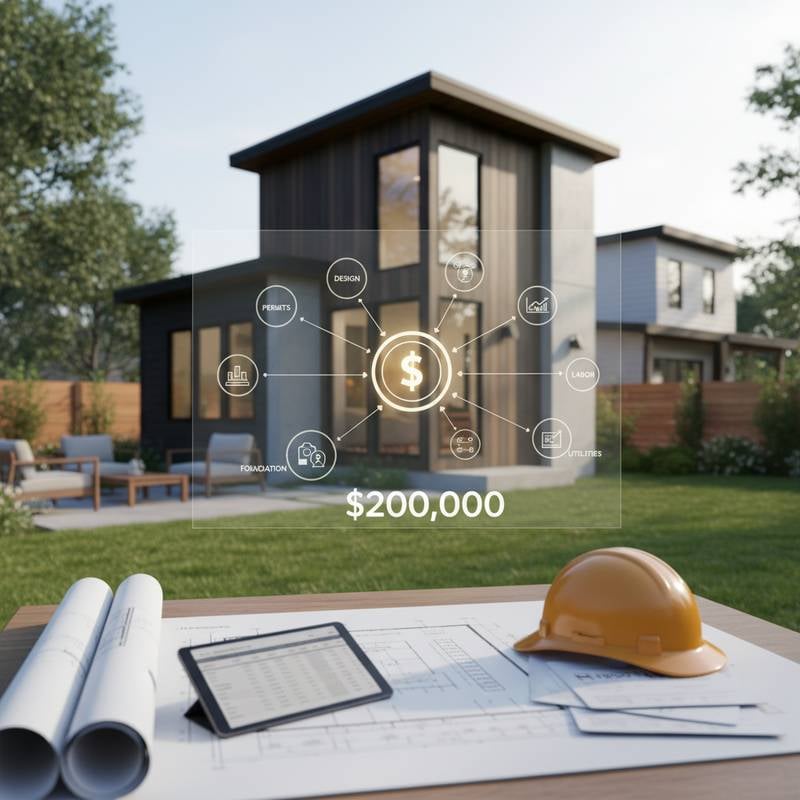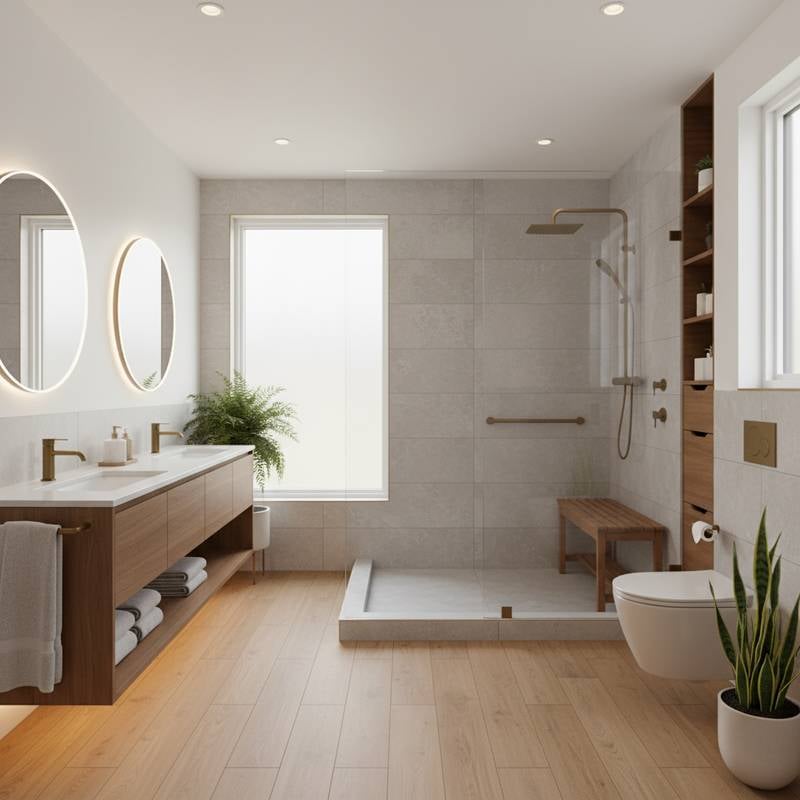2025 ADU Costs: Budget Smart for Granny Flat Builds
Adding a backyard cottage or granny flat creates flexible living space, increases property value, and generates rental income. Before beginning construction, a clear understanding of total costs proves essential. This guide assists in planning a realistic budget for an accessory dwelling unit (ADU), with explanations of how size, materials, and site conditions influence pricing. Readers gain insights into cost-saving strategies and effective project management from design through occupancy.
Understanding What Goes into ADU Pricing
Building an ADU differs from constructing a simple shed or renovating an interior room. The process requires full residential construction, encompassing foundation work, framing, roofing, insulation, plumbing, and electrical systems. Costs fluctuate based on the unit type, local labor rates, and selected finish levels.
The three primary ADU categories consist of the following:
- Detached ADU: A standalone small home in the backyard, commonly known as a backyard cottage or granny flat.
- Attached ADU: An addition to the main home that shares one or more walls.
- Garage Conversion: A transformation of an existing garage into a habitable unit.
Each category presents distinct cost ranges and construction challenges. Detached units generally incur higher expenses due to the need for new foundations and utility connections, whereas conversions reduce costs related to structure and roofing.
Average Cost Breakdown
Although precise figures depend on local conditions, a typical budget breakdown aids in effective planning. Consider the total cost as a series of interconnected layers.
-
Design and Permitting
Allocate funds for architectural drawings, engineering reports, and municipal permits. This stage confirms compliance with code requirements, such as energy efficiency standards and setback rules. -
Site Preparation
Tasks like clearing vegetation, grading land, or upgrading utilities contribute to expenses. Sloped terrain, restricted access, or inadequate drainage might necessitate extra excavation or retaining walls. -
Foundation and Framing
Concrete slab foundations suit most small ADUs, while raised foundations accommodate damp or uneven sites. The choice of high-quality lumber or steel framing affects both initial costs and long-term durability. -
Plumbing, Electrical, and HVAC
Utility connections significantly impact the overall budget. If the main home systems support additional load, savings result. Otherwise, installation of new service lines becomes necessary. -
Interior Finishes
Elements such as flooring, cabinetry, lighting, and fixtures span from basic to premium options. Midgrade selections often achieve an optimal balance of quality and affordability. Custom millwork or intricate tile patterns escalate expenses rapidly. -
Exterior Finishes and Landscaping
Aligning siding or roofing with the main home promotes visual harmony. Basic landscaping or a modest patio enhances the appearance without substantial outlay.
Key Factors That Affect Your Budget
Unique site and homeowner conditions shape every project. Knowledge of these primary influences enables more precise cost estimation.
Size and Layout
Smaller units result in lower total costs, though the per-square-foot price may rise due to fixed expenses like plumbing and permits. A compact design featuring an efficient floor plan provides the greatest value. Open layouts that integrate kitchen and living areas minimize wall framing and finishing materials.
Construction Type
Prefabricated ADUs reduce labor costs when local codes permit their use. Site-built units allow greater flexibility and customization. Conversions appear more economical but might demand significant upgrades if the existing structure falls short of residential codes.
Site Conditions
Flat, accessible lots simplify construction and lower expenses. Narrow driveways, mature trees, or utility easements could require specialized equipment or design modifications. Account for grading, drainage, and vehicle access during planning.
Finish Level
Premium finishes, including stone countertops, designer lighting, or bespoke cabinets, elevate total costs. Maintaining a cohesive yet straightforward style ensures an inviting atmosphere without excess spending. Practical, low-maintenance options like vinyl plank flooring or fiber cement siding serve well.
Labor and Regional Costs
Labor rates differ substantially across regions. Urban locations with strong demand for skilled tradespeople command higher prices than rural areas. Obtain multiple bids from licensed contractors prior to finalizing agreements.
Cost Ranges by Type of ADU
Projects vary widely, yet general comparisons offer a framework for anticipating expenses.
- Detached ADU: Typically the priciest choice, owing to comprehensive site preparation and utility installations.
- Attached ADU: More budget-friendly, as it shares walls, roofing, or foundations with the primary residence.
- Garage Conversion: Frequently the most affordable, assuming a structurally sound base and proximate utilities.
All types demand insulation, windows, and finishes that adhere to residential standards. Garage conversions still require new plumbing and electrical infrastructure to achieve habitability.
Smart Ways to Manage Costs
ADU construction involves complexity, but strategic planning controls expenses while preserving quality.
Simplify the Design
Opt for a rectangular or square footprint to reduce framing intricacies. Steer clear of multifaceted rooflines or dormers that inflate costs. Standard dimensions for windows and doors minimize material waste.
Use Modular or Prefab Components
Builders sometimes provide modular wall panels or prefabricated kitchen units to accelerate assembly. Preassembled roofing trusses or bathroom modules further decrease labor requirements.
Reuse or Recycle Materials
In garage or basement conversions, repurpose existing framing where feasible. Salvaged doors, hardware, or lighting fixtures impart character at reduced cost.
Plan for Energy Efficiency
Incorporate enhanced insulation, double-pane windows, and efficient heating or cooling systems to lower future utility bills. A compact heat pump or on-demand water heater suits small spaces effectively.
Bundle Work with the Main Home
If exterior or utility updates for the primary residence are planned, synchronize efforts. Shared trenching for water or electrical lines avoids duplicate labor.
Cost-Saving Design Choices
Thoughtful design yields both economies and enhanced livability. Emphasize functional materials and layouts over fleeting trends.
- Compact Kitchens: Implement two-wall or L-shaped configurations with open shelving for efficiency.
- Combined Spaces: Merge living and dining areas into a single open zone to optimize flow.
- Neutral Palettes: Employ light, neutral colors to expand the perceived size of interiors and accommodate varied users.
- Minimal Hallways: Maximize usable space in limited footprints by ensuring direct circulation paths.
When to Hire a Professional
DIY approaches appeal for their potential savings, yet ADUs demand expertise in complex systems and rigorous code adherence. Homeowners might manage tasks like painting or landscaping independently, but licensed experts must oversee structural framing, plumbing, and electrical installations. A general contractor orchestrates timelines and inspections, averting delays and added costs.
Sites with slopes, retaining walls, or access constraints benefit from professional input. Such builders devise compliant solutions that prioritize safety. Attempts to economize in these domains often result in escalated expenses down the line.
Preparing for Permits and Timelines
Municipalities establish specific ADU regulations, including size restrictions, setbacks, and parking mandates. Submit thorough plans with structural specifications to prevent resubmissions and approval delays. Certain regions offer expedited processes for standardized designs, shortening wait times.
Anticipate several weeks for design and permitting prior to construction commencement. Post-approval, timelines vary by project complexity and weather. Prefabricated units assemble more swiftly, whereas site-built options extend durations but permit extensive customization.
Financing Your ADU
Multiple funding avenues exist for ADU projects:
- Home Equity Loan or Line of Credit: Leverages existing property equity for competitive interest rates.
- Construction Loan: Finances the entire build and transitions to a standard mortgage upon completion.
- Cash-Out Refinance: Replaces the current mortgage with a larger loan that incorporates project capital.
- Personal Savings: Eliminates interest charges but constrains project scale.
Evaluate prospective rental revenue or property appreciation to gauge return on investment before proceeding.
Long-Term Value and Maintenance
A thoughtfully constructed ADU fulfills diverse roles across years, from guest accommodations to family housing or income generation. Selecting robust materials upfront minimizes repairs and upkeep. Fiber cement siding, composite decking, and metal roofing withstand moisture and wear effectively. Interior choices that facilitate easy cleaning endure regular use.
Conduct routine checks on roofs, gutters, and plumbing to safeguard the investment. Landscaping that channels water from the foundation averts persistent problems. Consistent maintenance sustains comfort and appeal for generations.










